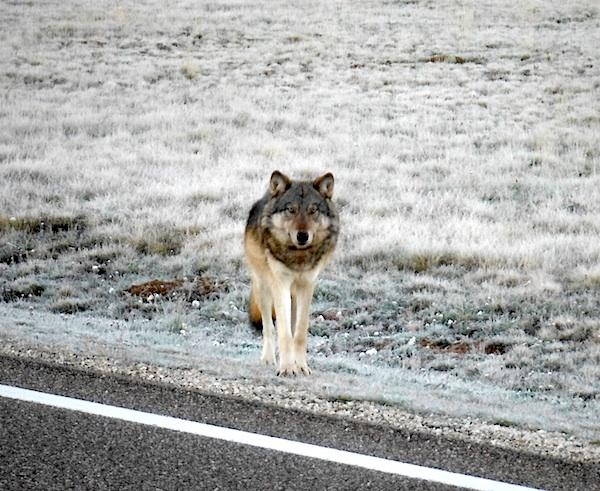
A DNA analysis has determined that this is a female gray wolf from the Rocky Mountains.
A female gray wolf that dispersed from the Rocky Mountains, presumably in search of a mate and new territory, has been roaming the North Rim of Grand Canyon National Park, according to a DNA analysis performed for the U.S. Fish and Wildlife Service.
The confirmation announced Friday came from analysis on a scat sample conducted by the University of Idaho's Laboratory for Ecological, Evolutionary and Conservation Genetics. The lab now will turn to comparing that DNA to DNA samples taken from other female Rocky Mountain gray wolves to see if it can pinpoint where the North Rim wolf came from.
'The DNA results indicate this wolf traveled at least 450 miles from an area in the northern Rocky Mountains to northern Arizona,' Benjamin Tuggle, the Fish and Wildlife Service's Southwest regional director, said in a release. 'Wolves, particularly young wolves, can be quite nomadic dispersing great distances across the landscape. Such behavior is not unusual for juveniles as they travel to find food or another mate.'
The scat sample was obtained Nov. 2 by researchers. Efforts to capture the wolf to obtain a blood sample and replace a worn radio collar were unsuccessful and suspended due to cold weather, the agency said.
'It is so exciting to see a wolf in the Grand Canyon once again, especially since it has been over 70 years since they were exterminated in the region," Eva Sargent, director of Southwest Programs for Defenders of Wildlife, said in a prepared statement. "Science has established that there is great habitat for these iconic animals in the Grand Canyon ecoregion, and this female gray wolf's presence on the North Rim is proof that the science is right.
'This wolf's journey is an example of what gray wolf recovery should look like: animals naturally dispersing to find suitable habitat," she added. "It also reinforces just how critical continued federal protections for gray wolves are right now. Because gray wolves are still federally protected in the majority of the continental United States, this wolf was able to safely migrate over 450 miles through states like Colorado to seek out some of her ancestors' most favored habitat."
With the confirmation, the wolf automatically gains protected under the Endangered Species Act, according to Defenders of Wildlife.
The Fish and Wildlife Service had posted a notice on the Federal Register earlier this month announcing that it had given the OK for "authorized qualified researchers to capture, draw blood, and possibly affix a brightly colored GPS radio collar on the suspect wolf and release it back into the general area where it was captured."
The animal was first spotted October 6 wandering in the area of the North Rim, the Service said. Since deer season is under way, "it is believed that the wolf may be in danger of possible harm and could accidentally be shot either as a result of misunderstanding of status or misidentification," the notice said.
According to Defenders of Wildlife, "Wolves from the north and south historically met, interbred and thrived in the Grand Canyon ecoregion and the Southern Rockies. There were once up to two million gray wolves living in North America, but the animals had been driven to near-extinction in the lower 48 states by the early 1900s. After passage of the federal Endangered Species Act in 1973 and protection of the wolf as endangered, federal recovery programs resulted in the rebound of wolf populations in limited parts of the country. Roughly 5,500 wolves now live in the continental United States, but today, the species only occupies approximately 36 percent of their suitable range ' remaining absent from huge swaths of wilderness that provide excellent habitat but are missing wolves as an essential component of ecosystem function. Places like the Grand Canyon ecoregion, Olympic Peninsula in Washington, much of western Colorado, northern California and parts of Utah could all be a home to wolves once again, bringing both ecological and economic benefits to local communities.
"Wolves are an iconic, native species that play a vital role in restoring healthy ecosystems by keeping prey species in balance. In 2013, the Service proposed a federal delisting of gray wolves across the country. In the event of a delisting, management of wolves would be determined by individual states. Wolves are still not recovered in significant portions of their range and are not secure in areas of the country where they have already been delisted. Aggressive hunting, trapping and lethal control in Idaho, Montana and Wyoming are undermining the progress made since wolves were reintroduced in the Northern Rockies in 1995."



Comments
I'm going to predict that this animal's lifespan will be very short.
A favorite mantra in this part of the country is "Shoot, Shovel, Shutup."